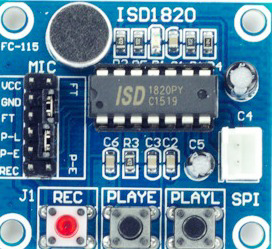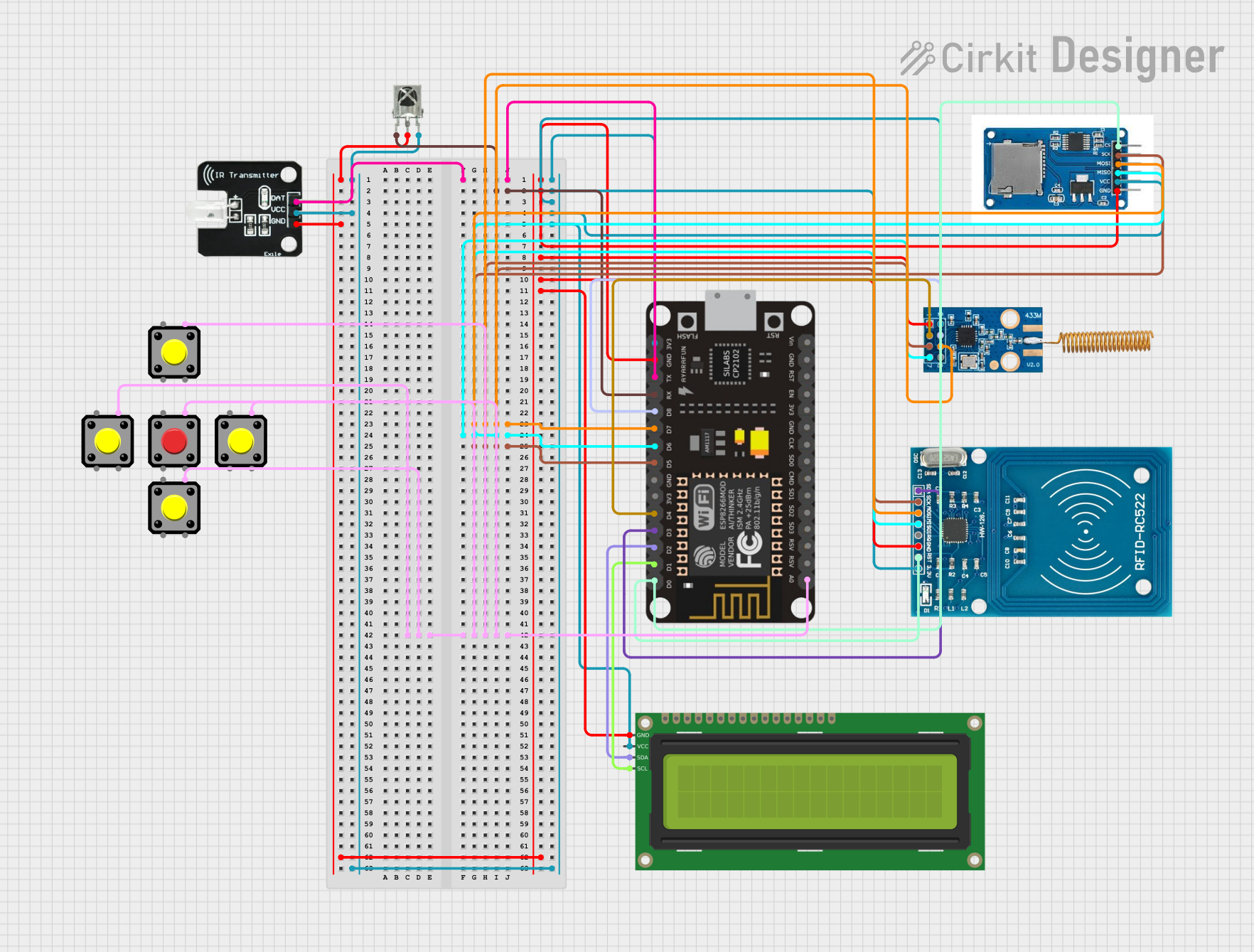
How to Use ISD1820: Examples, Pinouts, and Specs

 Design with ISD1820 in Cirkit Designer
Design with ISD1820 in Cirkit DesignerIntroduction
The ISD1820 is a highly integrated, high-quality, single-chip voice recording and playback device ideally suited for a variety of electronic systems. The module can record up to 20 seconds of audio data, which can be played back through a built-in audio amplifier and speaker output. Common applications include voice memos, talking toys, alarm systems, and automated response systems.
Explore Projects Built with ISD1820

 Open Project in Cirkit Designer
Open Project in Cirkit Designer
 Open Project in Cirkit Designer
Open Project in Cirkit Designer
 Open Project in Cirkit Designer
Open Project in Cirkit Designer
 Open Project in Cirkit Designer
Open Project in Cirkit DesignerExplore Projects Built with ISD1820

 Open Project in Cirkit Designer
Open Project in Cirkit Designer
 Open Project in Cirkit Designer
Open Project in Cirkit Designer
 Open Project in Cirkit Designer
Open Project in Cirkit Designer
 Open Project in Cirkit Designer
Open Project in Cirkit DesignerTechnical Specifications
Key Technical Details
- Operating Voltage: 2.4V to 5.5V
- Recording Time: 8 to 20 seconds (adjustable quality)
- Sampling Rate: 3.2 kHz to 8 kHz
- Speaker Output: 8Ω, typically 0.5W
- Microphone: Onboard electret microphone
- Current Consumption: 25 mA (typical during playback)
Pin Configuration and Descriptions
| Pin Number | Pin Name | Description |
|---|---|---|
| 1 | VCC | Power supply (2.4V to 5.5V) |
| 2 | GND | Ground |
| 3 | REC | Record button input (active low) |
| 4 | PLAYE | Edge-activated play button input (active low) |
| 5 | PLAYL | Level-activated play button input (active low) |
| 6 | SP+ | Speaker positive output |
| 7 | SP- | Speaker negative output |
| 8 | FT | Feed-through mode enable (active low) |
| 9 | P-E | Playback end output (active low) |
| 10 | ANA OUT | Analog output (for external amplifiers) |
| 11 | ANA IN | Analog input (for external audio sources) |
| 12 | MIC_REF | Microphone bias reference voltage |
| 13 | AGC | Automatic gain control for microphone input |
| 14 | VCC | Power supply (2.4V to 5.5V) |
Usage Instructions
How to Use the ISD1820 in a Circuit
Powering the Module:
- Connect the VCC pin to a 2.4V to 5.5V power source.
- Connect the GND pin to the ground of the power source.
Recording Audio:
- Press and hold the REC pin to ground to start recording.
- Release the REC pin to stop recording.
Playback Audio:
- Briefly connect the PLAYE pin to ground to play the entire message once.
- Connect the PLAYL pin to ground to play the message repeatedly until the pin is released.
Connecting a Speaker:
- Connect the speaker's positive terminal to the SP+ pin.
- Connect the speaker's negative terminal to the SP- pin.
Important Considerations and Best Practices
- Ensure that the power supply voltage does not exceed 5.5V to prevent damage to the module.
- Keep the recording and playback volume at a moderate level to avoid distortion.
- Place the microphone away from the speaker to prevent feedback.
- Use a shielded cable if extending the microphone or speaker wires to reduce noise.
Troubleshooting and FAQs
Common Issues
No Sound During Playback:
- Check the speaker connections.
- Ensure that the power supply is within the specified range.
- Verify that a recording has been made.
Low Recording Quality:
- Adjust the distance from the microphone during recording.
- Reduce background noise when recording.
Playback Starts Automatically:
- Ensure that the PLAYL pin is not unintentionally grounded.
Solutions and Tips for Troubleshooting
- If the module is not functioning, double-check all connections and ensure that the power supply is stable and within the specified range.
- For better audio quality, consider using an external amplifier connected to the ANA OUT pin.
- If the playback volume is too low, check the speaker's impedance and power rating. Use an 8Ω, 0.5W speaker for optimal performance.
FAQs
Q: Can I extend the recording time beyond 20 seconds? A: The recording time is fixed based on the internal memory of the ISD1820. To achieve longer recording times, consider using an external memory chip or a different model with a larger memory capacity.
Q: How can I erase a recording? A: To erase a recording, simply record a new message over the previous one. There is no separate erase function.
Q: Can I use the ISD1820 with an Arduino? A: Yes, the ISD1820 can be easily interfaced with an Arduino for more complex control over recording and playback functions.
Example Arduino Code
// Define ISD1820 pin connections
const int recPin = 2; // REC connected to digital pin 2
const int playPin = 3; // PLAYE connected to digital pin 3
void setup() {
pinMode(recPin, OUTPUT);
pinMode(playPin, OUTPUT);
// Start with both pins high (inactive)
digitalWrite(recPin, HIGH);
digitalWrite(playPin, HIGH);
}
void loop() {
// Record for 5 seconds
digitalWrite(recPin, LOW); // Start recording
delay(5000); // Record for 5 seconds
digitalWrite(recPin, HIGH); // Stop recording
delay(1000); // Wait for 1 second
// Playback the recorded message
digitalWrite(playPin, LOW); // Start playback
delay(100); // Short delay
digitalWrite(playPin, HIGH); // Stop playback
delay(5000); // Wait for 5 seconds before next loop
}
Note: The above code is a simple example to demonstrate recording and playback using an Arduino. In a practical application, you would typically use buttons or sensors to trigger these actions.